![]()
![]()
![]()
Use LEFT and RIGHT arrow keys to navigate between flashcards;
Use UP and DOWN arrow keys to flip the card;
H to show hint;
A reads text to speech;
39 Cards in this Set
- Front
- Back
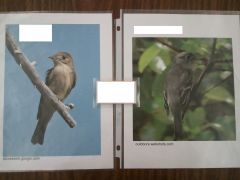
|
Tyrannidae
Tyrant Flycatchers Broad base of bill • Bristles around mouth • Weakly crested head • Most are not colourful • Perch in open and hunt for flying insect prey |
|
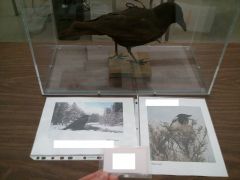
|
Corvidae
Jays, crows, ravens, magpies and nutcrackers • Overall, large songbirds • Small, stiff, decumbent feathers at base of upper mandible • Straight, robust bill • Often with iridescent colours • Omnivorous • Intelligent! |
|
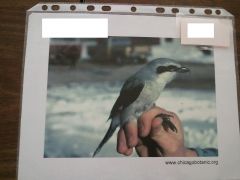
|
Laniidae
Shrikes Only songbirds with a hawk-like bill (hooked witha tooth and notch) Sharp raptor-like claws • Gray, black and white • Some impale their prey! – Insects – Small mammals |
|
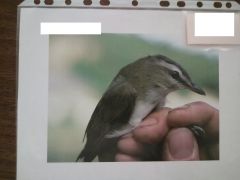
|
Vireonidae
Vireos Dull-coloured • Short bill, neck, and legs • Medium-length tail • Resemble warblers • Have a small hook on bill • Forage for insects in tree foliage and large bushes |
|
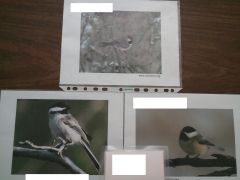
|
Paridae
Chickadees • Small birds with large heads • Pointed, short bill • Nostrils overlain with bristles • Eat insects and seeds |
|

|
Alaudidae
Larks Brownish • Long claws, esp. hallux • Back of tarsus is rounded and scaled • Feed on the ground • Larks walk on the ground (vs. sparrows, who hop) • Horned lark is our only species |
|
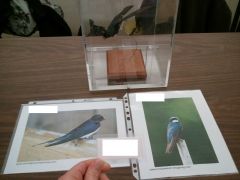
|
Hirundinidae
Swallows and Martins • Short, flattened bill • Elongate wings; streamlined • Generally dark, iridescent plumage with lighter underside • Feed on insects in the air |
|

|
Aegithalidae
Bushtit • Small, gray, chickadee-like • Much like wrentit, but plumage is not streaked on the belly • Long tail • Insectivorous • Only one species in North America (West of Rockies) |
|
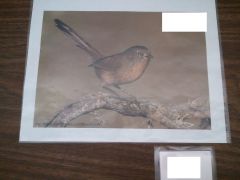
|
Timaliidae
Wrentit Small, dark, chickadee-like • Long tail, light eyes • Streaking on belly • Insectivorous • Only one NA sp. • Closest ones to us are on the US Pacific Coast |
|
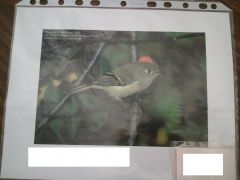
|
Regulidae
Kinglets • Small birds with short bill • Warbler-like • Dense plumage • Often a patch of colour on top of the head • Insectivorous |
|
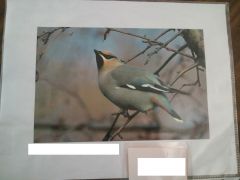
|
Bombycillidae
Waxwings and Phainopepla • Waxwings in Edmonton • Crested • Sleek plumage • “Waxy” blobs on tips of secondary feathers • Yellow band at tail-tip • Huge flocks of Bohemian waxwings in late winter |
|

|
Cinclidae
Dippers • Small with short tail and short wings • Gray overall colour • Live along mountain streams in summer, and along large rivers in winter • Feed underwater by swimming with their wings! |
|

|
Turdidae
Thurshes, Blubirds, Robins • Robin-like in form • A few rictal bristles • Longish tail (square or rounded) • Most are mottled brown and white (except bluebird and robin) • Forage near ground |
|
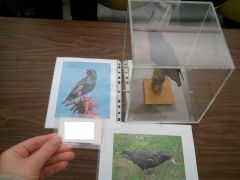
|
Sturnidae
Starlings and Mynahs • Medium-sized, dark birds • Straight bill, short tail, strong legs • Iridescent colours • Noisy – can mimic other birds • Crested mynah: formerly introduced to Vancouver, but now extinct in N. America |
|
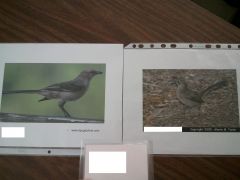
|
Mimidae
Thrashers, catbirds, mockingbirds • Resemble thrushes, but many species have decurved bill and long tail • Short, rounded wings • Vocalizations often repetitious • Some are great mimics of other birds’ vocalizations |
|
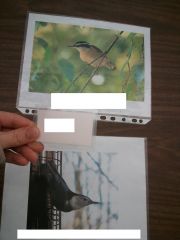
|
Sittidae
Nuthatches • Unstreaked plumage • Pointed bill, angled lower mandible – unique bill shape • Cling to bark, head-down • Feed on insects and seeds |
|
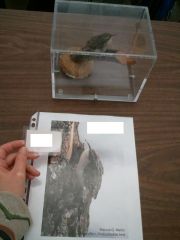
|
Certhiidae
Creepers • Unstreaked plumage • Pointed bill, angled lower mandible – unique bill shape • Cling to bark, head-down • Feed on insects and seeds |
|
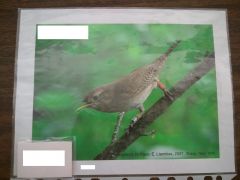
|
Troglodytidae
Wrens, Gnatcatchers, and Verdin • Pointed bill, slightly decurved • Upturned tail, often • Gnatcatchers – mostly gray • Verdin – bright yellow head • Insectivorous |
|

|
Parulidae
New World Warblers • Small birds • Slender, pointed bills • Males often brightly coloured (breeding plumage) • Insectivorous |
|
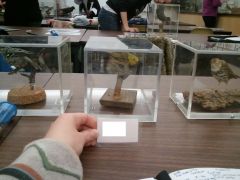
|
Parulidae
New World Warblers • Small birds • Slender, pointed bills • Males often brightly coloured (breeding plumage) • Insectivorous |
|
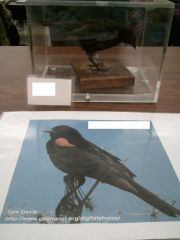
|
Icteridae
Blackbirds, Orioles, Meadowlarks and Grackles • Slender, straight bill • Straight upper edge of upper mandible (culmen) • Some streaked and brown, some colourful • Insect and seed eating |
|
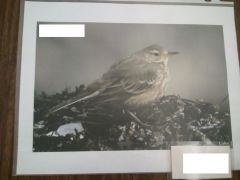
|
Motacillidae
Pipits and wagtails • Ground dwelling • Long hallux claw • Slender bill • Long tails and legs • Feed on ground • Sprague’s Pipit breeds in the prairies |
|
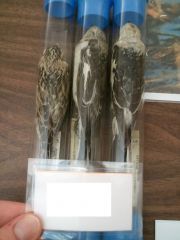
|
Calcariidae
|
|
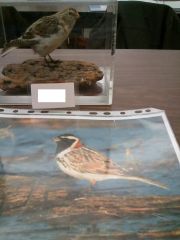
|
Calcariidae
• Previously placed in the family Emberizidae • Genus Plectrophenax – Snow and McKay’s Bunting • Genus Calcarius – Longspurs |
|
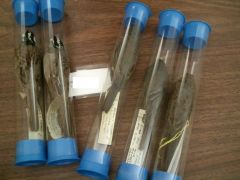
|
Emberizidae
New World Sparrows • Large group with many similar looking species • Finch-like birds • Often brownish, streaked plumage • Often feed on ground |
|

|
Cardinalidae
Cardinals, some Grosbeaks, N.A. Tanagers • Finch-like birds • Heavy, conical bill • Simple, colourful plumage • Seed-eaters, largely |
|

|
Cardinalidae
Cardinals, some Grosbeaks, N.A. Tanagers • Finch-like birds • Heavy, conical bill • Simple, colourful plumage • Seed-eaters, largely |
|
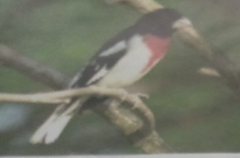
|
Cardinalidae, Rose-breasted Grosbeak
|
|

|
Cardinalidae, Northern Cardinal
|
|

|
Cardinalidae, N.A. Tanager
• You need to be able to recognize North American Tanagers: – Brightly coloured birds, often with black wings or markings – Bill more adapted for fruit and insect eating (elongated) |
|
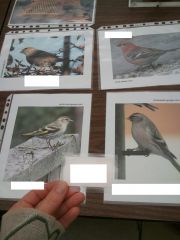
|
Fringillidae
Finches, some Grosbeaks, Redpolls, Siskins and Crossbills • Short, conical bill • Can be brightly coloured, though some are brownish • Small to medium sized • Often seen in winter • Frequently seen at bird feeders |
|
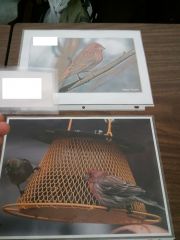
|
Fringillidae
Finches, some Grosbeaks, Redpolls, Siskins and Crossbills • Short, conical bill • Can be brightly coloured, though some are brownish • Small to medium sized • Often seen in winter • Frequently seen at bird feeders |
|
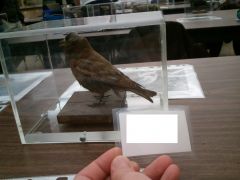
|
Fringillidae
Finches, some Grosbeaks, Redpolls, Siskins and Crossbills • Short, conical bill • Can be brightly coloured, though some are brownish • Small to medium sized • Often seen in winter • Frequently seen at bird feeders |
|
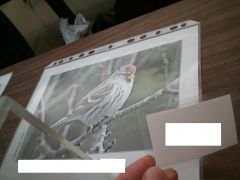
|
Fringillidae
Finches, some Grosbeaks, Redpolls, Siskins and Crossbills • Short, conical bill • Can be brightly coloured, though some are brownish • Small to medium sized • Often seen in winter • Frequently seen at bird feeders |
|

|
Fringillidae, Red Crossbill
Finches, some Grosbeaks, Redpolls, Siskins and Crossbills • Short, conical bill • Can be brightly coloured, though some are brownish • Small to medium sized • Often seen in winter • Frequently seen at bird feeders |
|
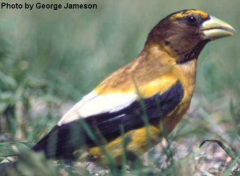
|
Fringillidae, Evening Grosbeak
Finches, some Grosbeaks, Redpolls, Siskins and Crossbills • Short, conical bill • Can be brightly coloured, though some are brownish • Small to medium sized • Often seen in winter • Frequently seen at bird feeders |
|
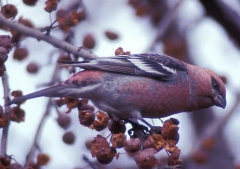
|
Fringillidae, Pine Grosbeak
Finches, some Grosbeaks, Redpolls, Siskins and Crossbills • Short, conical bill • Can be brightly coloured, though some are brownish • Small to medium sized • Often seen in winter • Frequently seen at bird feeders |
|

|
Passeridae
House Sparrows • Introduced from Europe • Sparrow-like • Short, conical bill • Feed on or near ground for insects and seeds • Social, chattery |
|

|
Passeridae
House Sparrows • Introduced from Europe • Sparrow-like • Short, conical bill • Feed on or near ground for insects and seeds • Social, chattery |

